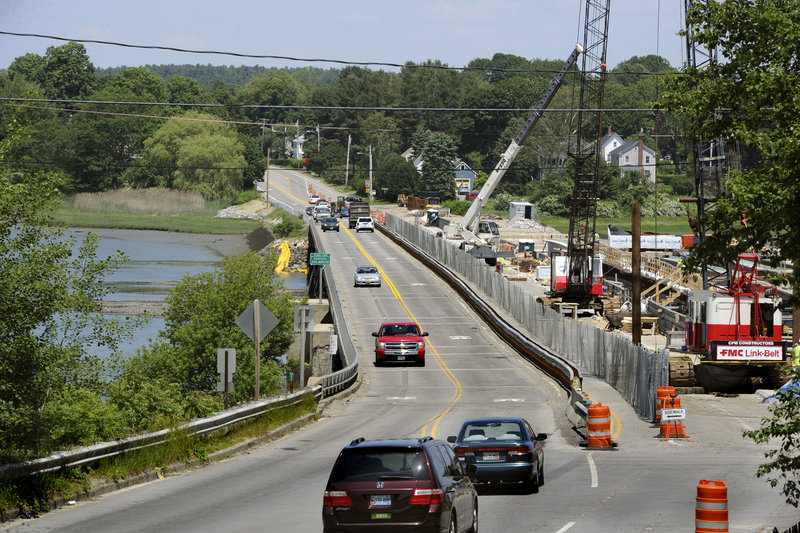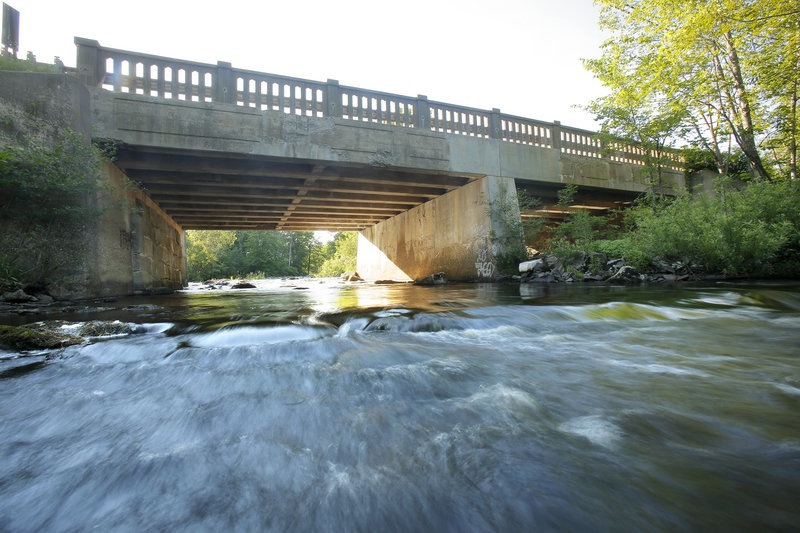Maine reduced its number of structurally deficient bridges by 8.5 percent from 2011 to 2012, but the state still ranks in the national top 10 for the highest percentage of deficient bridges, according to a recent study.
The national safety advocacy group Transportation for America ranked Maine ninth among 50 states, with slightly more than one of every seven bridges classified as deficient by Federal Highway Administration standards.
That designation doesn’t mean a bridge is unsafe, only that it needs significant repair or maintenance to remain in use.
Even though Maine reduced its number of deficient bridges last year, state transportation officials say the study highlights that funding is still lacking for work on all the bridges that need it.
“We’re constantly inspecting and evaluating bridges so we can prioritize,” said Department of Transportation spokesman Ted Talbot. “Each state has an aging infrastructure and our needs always exceed available funds.”
U.S. Rep. Mike Michaud of Maine, a member of the House Transportation and Infrastructure Committee, used the study this week to push for increased funding.
Michaud and other legislators have sponsored the SAFE Bridges Act, which would provide $2.75 billion to states for bridge repair in 2013 and 2014. The act would distribute funds among states through a needs-based formula, based on each state’s share of deficient bridges.
Michaud also sent a letter to the House Appropriations Committee this week requesting more money for bridges in its transportation funding bill. Most bridge projects in Maine are funded through a 80-20 split between federal and state funds.
“Maine has made strides like many other states, but more resources and attention need to be paid to our aging infrastructure,” Michaud said in a prepared statement. “This is a safety and economic issue. We can’t compete in a global economy if we allow our transportation networks to decay.”
Two major bridge collapses – one on Interstate 5 in Washington state in May, the other on state Route 202 in Arizona this week – highlight the fragile state of the country’s transportation infrastructure. The bridge in Washington had last been inspected in November, and the inspection report noted that several parts already had damage from being hit by big rigs.
Maine has slightly more than 2,400 bridges, 356 of them classified as deficient last year. With 14.8 percent of its bridges deemed deficient, Maine was above the national average of 11 percent, but well below Pennsylvania, which had the highest percentage, 24.5.
Florida and Nevada were the lowest, with 2.2 percent of their bridges classified as deficient.
A highway bridge has three primary components: the deck, the substructure and the superstructure. During an inspection, each component is given a rating from 0 to 9. If any component is rated 4 or below, the bridge is classified as deficient.
Federal law requires states to inspect all bridges that are at least 20 feet long every two years. Maine inspects its bridges once a year, and sometimes inspects deficient bridges more frequently, Talbot said.
If a bridge is deemed unsafe — meaning it cannot support the average daily traffic — immediate action is taken, with the span posted for lower weight, or closed. Talbot said no bridge in Maine is classified as unsafe.
The study’s 2012 list of 356 deficient bridges in Maine is no longer completely up to date, since some bridges deemed deficient have been repaired or rehabilitated, and other bridges have been moved onto the list.
Talbot said bridge inspectors submit regular reports to the Department of Transportation’s engineers, who decide which projects need immediate attention based on the funding available. Factors such as how heavily a bridge is used also are considered.
The state’s work plan for 2013, 2014 and 2015 includes 126 bridge-related projects ranging from minor repairs to full replacement. Among those scheduled for replacement are the Route 9 bridge in Scarborough, the Bridge Street bridge in Westbrook, the Route 201 bridge between Brunswick and Topsham, the Pine Street bridge between Biddeford and Saco, and the Route 4A bridge that connects Hollis and Buxton.
Maria Fuentes, executive director of the Maine Better Transportation Association, said the Department of Transportation has done a good job prioritizing bridge projects.
“But we can’t expect them to predict correctly how long a bridge might last before it needs immediate repair,” she said.
The biggest factor in determining whether a bridge is deficient is its age. On average, structurally deficient bridges are 22 years older than all other bridges, according to the Transportation for America study. Thousands of bridges were built across the country in the 1950s and 1960s to accommodate the federal highway system.
The Federal Highway Administration estimates that it would cost $76 billion to repair all deficient bridges nationwide. Maine does not have an estimate for what it would cost to repair all of its deficient bridges.
Eric Russell can be contacted at 791-6344 or at:
erussell@pressherald.com
Twitter: @PPHEricRussell
Send questions/comments to the editors.





Success. Please wait for the page to reload. If the page does not reload within 5 seconds, please refresh the page.
Enter your email and password to access comments.
Hi, to comment on stories you must . This profile is in addition to your subscription and website login.
Already have a commenting profile? .
Invalid username/password.
Please check your email to confirm and complete your registration.
Only subscribers are eligible to post comments. Please subscribe or login first for digital access. Here’s why.
Use the form below to reset your password. When you've submitted your account email, we will send an email with a reset code.